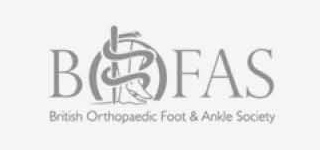A guide to surgical procedures
Surgical treatments I offer include percutaneous minimally invasive foot surgery, bunion correction, ligament repairs and reconstruction, ankle arthroscopy (key hole surgery), joint fusions, synthetic cartilage implantation, complex deformity correction, ankle replacement, and fracture fixation.
PROCEDURES
Limb lengthening
Limb lengthening has to be undertaken in a slow gradual fashion. It involves a controlled break in the bone, followed by slowly pulling the 2 parts of the bone apart over many days or even weeks. This can be achieved either with the use of special external fixation devices or, in suitable cases, with motorised lengthening intra-medullary devices such as PRECICE ®.
Deformity correction
There are multiple commonly performed deformity correction procedures in foot and ankle surgery for a whole spectrum of various deformities. The nature of the corrective surgery is guided by the nature and severity of the deformity and the functional problems and symptoms causing concern. Corrective surgery usually involves a combination of bone and soft tissue procedures. The bone procedures may be joint preserving in the form of osteotomies, or joint sacrificing in the form of fusions. Occasionally, in very complex cases, the use of an external fixation device to undertake a gradual deformity correction may be needed.
Ankle ligament reconstruction
In cases of chronic ankle instability following injury, it is possible to reconstruct these ligaments to improve stability and function and reduce pain. There are various techniques for reconstructing the ligaments, but most commonly the ligaments are reattached to the bones and tightened up using small ‘anchors’ fixed into the bones. The post-operative rehabilitation process is critical in achieving in a great outcome.
Total ankle replacement
Through an incision made at the front of the ankle, the damaged joint surfaces are removed and replaced with an artificial joint. The replacement is made of metal and plastic and is fixed to the bone with a special coating. Unlike ankle fusion surgery, following an ankle replacement it is still possible to move the ankle joint, although the painful joint surfaces are gone.
Achilles tendon repair/ reconstruction
When there is a new tear or rupture of the Achilles tendon, and surgery is indicated, it can usually be directly repaired. However, in more complex cases where there had been delayed diagnosis, re-rupture or chronic degeneration of the tendon, other reconstruction techniques may be needed, sometimes involving the use of a tendon transfer.
Ankle fusion
This procedure involves removing the damaged joint surfaces from the ankle and then fixing the bones together. In most cases it is performed arthroscopically (i.e. keyhole techniques) and is usually carried out under general anaesthetic. Following successful ankle fusion, the ankle joint itself will not move, but there will still be plenty of foot movement through the numerous other joints in the foot, and so function remains very good.
One celebrity TV presenter with an ankle fusion is Steve Backshall, who appeared in the 2014 series of BBC’s ‘Strictly Come Dancing’. You can watch his performances on You Tube (http://www.youtube.com/watch?v=c1sWGaKTnh8) to judge for yourself the degree of function possible following ankle fusion surgery.
Ankle arthroscopy (Keyhole surgery)
This is a minimally invasive procedure to examine the inside of the ankle joint and undertake certain treatments. It involves using a camera and special instruments inserted through very small surgical cuts (usually 2 cuts) at the front of the ankle joint. Many procedures can be performed using this technique including removal of scar tissue, inflamed synovium and loose fragments, ‘tidy up’ of worn cartilage, shaving of bony bumps, and even ankle fusion. Ankle arthroscopy surgery is usually carried out under General Anaesthetic, as a day case procedure.
Straightening toes

Lesser toe deformities (such as hammer toes, claw toes, mallet toes, curly toes or overlapping toes) are a very common complaint. For the majority of people, the problem is just cosmetic, but in some cases the deformity can lead to pain, corns or ulcers, and difficulty fitting into footwear.

When non-operative treatments such as toe spacers and pads have failed, then surgical correction may be of benefit. This can usually be done under local anaesthetic as a daycase procedure, and can sometimes be done with a minimally invasive percutaneous technique (as shown on left. Post-operative picture only 2 weeks after surgery).
Excision of interdigital neuoma
When this common cause of foot pain fails to respond to non-operative treatment, then surgical excision of the neuroma is an option. It is a very quick and simple day-case procedure to remove a portion of the affected nerve through a small incision. It may result in some permanent numbness between the toes.
1st MTPJ Fusion
This is where the two bones of the joint at the base of the big toe are realigned and fused together and is only usually carried out if degeneration of the joint is too severe or if deformity of the big toe makes it unfeasible to fix the joint. Essentially the surgery aims to trade a painful and usually stiff joint for a painless, completely stiffened one. Although this results in permanent stiffness where the joint was, function is usually excellent. Patients have been known to run marathons after this surgery, and there are many professional athletes and sportsmen, including tennis star Lleyton Hewitt, who have successfully undergone the surgery.
Limb lengthening has to be undertaken in a slow gradual fashion. It involves a controlled break in the bone, followed by slowly pulling the 2 parts of the bone apart over many days or even weeks. This can be achieved either with the use of special external fixation devices or, in suitable cases, with motorised lengthening intra-medullary devices such as PRECICE ®.
There are multiple commonly performed deformity correction procedures in foot and ankle surgery for a whole spectrum of various deformities. The nature of the corrective surgery is guided by the nature and severity of the deformity and the functional problems and symptoms causing concern. Corrective surgery usually involves a combination of bone and soft tissue procedures. The bone procedures may be joint preserving in the form of osteotomies, or joint sacrificing in the form of fusions. Occasionally, in very complex cases, the use of an external fixation device to undertake a gradual deformity correction may be needed.
Ankle ligament reconstruction
In cases of chronic ankle instability following injury, it is possible to reconstruct these ligaments to improve stability and function and reduce pain. There are various techniques for reconstructing the ligaments, but most commonly the ligaments are reattached to the bones and tightened up using small ‘anchors’ fixed into the bones. The post-operative rehabilitation process is critical in achieving in a great outcome.
Total ankle replacement
Through an incision made at the front of the ankle, the damaged joint surfaces are removed and replaced with an artificial joint. The replacement is made of metal and plastic and is fixed to the bone with a special coating. Unlike ankle fusion surgery, following an ankle replacement it is still possible to move the ankle joint, although the painful joint surfaces are gone.
Achilles tendon repair/ reconstruction
When there is a new tear or rupture of the Achilles tendon, and surgery is indicated, it can usually be directly repaired. However, in more complex cases where there had been delayed diagnosis, re-rupture or chronic degeneration of the tendon, other reconstruction techniques may be needed, sometimes involving the use of a tendon transfer.
Ankle fusion
This procedure involves removing the damaged joint surfaces from the ankle and then fixing the bones together. In most cases it is performed arthroscopically (i.e. keyhole techniques) and is usually carried out under general anaesthetic. Following successful ankle fusion, the ankle joint itself will not move, but there will still be plenty of foot movement through the numerous other joints in the foot, and so function remains very good.
One celebrity TV presenter with an ankle fusion is Steve Backshall, who appeared in the 2014 series of BBC’s ‘Strictly Come Dancing’. You can watch his performances on You Tube (http://www.youtube.com/watch?v=c1sWGaKTnh8) to judge for yourself the degree of function possible following ankle fusion surgery.
Ankle arthroscopy (Keyhole surgery)
This is a minimally invasive procedure to examine the inside of the ankle joint and undertake certain treatments. It involves using a camera and special instruments inserted through very small surgical cuts (usually 2 cuts) at the front of the ankle joint. Many procedures can be performed using this technique including removal of scar tissue, inflamed synovium and loose fragments, ‘tidy up’ of worn cartilage, shaving of bony bumps, and even ankle fusion. Ankle arthroscopy surgery is usually carried out under General Anaesthetic, as a day case procedure.
Straightening toes

Lesser toe deformities (such as hammer toes, claw toes, mallet toes, curly toes or overlapping toes) are a very common complaint. For the majority of people, the problem is just cosmetic, but in some cases the deformity can lead to pain, corns or ulcers, and difficulty fitting into footwear.

When non-operative treatments such as toe spacers and pads have failed, then surgical correction may be of benefit. This can usually be done under local anaesthetic as a daycase procedure, and can sometimes be done with a minimally invasive percutaneous technique (as shown on left. Post-operative picture only 2 weeks after surgery).
Excision of interdigital neuoma
When this common cause of foot pain fails to respond to non-operative treatment, then surgical excision of the neuroma is an option. It is a very quick and simple day-case procedure to remove a portion of the affected nerve through a small incision. It may result in some permanent numbness between the toes.
1st MTPJ Fusion
This is where the two bones of the joint at the base of the big toe are realigned and fused together and is only usually carried out if degeneration of the joint is too severe or if deformity of the big toe makes it unfeasible to fix the joint. Essentially the surgery aims to trade a painful and usually stiff joint for a painless, completely stiffened one. Although this results in permanent stiffness where the joint was, function is usually excellent. Patients have been known to run marathons after this surgery, and there are many professional athletes and sportsmen, including tennis star Lleyton Hewitt, who have successfully undergone the surgery.
In cases of chronic ankle instability following injury, it is possible to reconstruct these ligaments to improve stability and function and reduce pain. There are various techniques for reconstructing the ligaments, but most commonly the ligaments are reattached to the bones and tightened up using small ‘anchors’ fixed into the bones. The post-operative rehabilitation process is critical in achieving in a great outcome.
Through an incision made at the front of the ankle, the damaged joint surfaces are removed and replaced with an artificial joint. The replacement is made of metal and plastic and is fixed to the bone with a special coating. Unlike ankle fusion surgery, following an ankle replacement it is still possible to move the ankle joint, although the painful joint surfaces are gone.
Achilles tendon repair/ reconstruction
When there is a new tear or rupture of the Achilles tendon, and surgery is indicated, it can usually be directly repaired. However, in more complex cases where there had been delayed diagnosis, re-rupture or chronic degeneration of the tendon, other reconstruction techniques may be needed, sometimes involving the use of a tendon transfer.
Ankle fusion
This procedure involves removing the damaged joint surfaces from the ankle and then fixing the bones together. In most cases it is performed arthroscopically (i.e. keyhole techniques) and is usually carried out under general anaesthetic. Following successful ankle fusion, the ankle joint itself will not move, but there will still be plenty of foot movement through the numerous other joints in the foot, and so function remains very good.
One celebrity TV presenter with an ankle fusion is Steve Backshall, who appeared in the 2014 series of BBC’s ‘Strictly Come Dancing’. You can watch his performances on You Tube (http://www.youtube.com/watch?v=c1sWGaKTnh8) to judge for yourself the degree of function possible following ankle fusion surgery.
Ankle arthroscopy (Keyhole surgery)
This is a minimally invasive procedure to examine the inside of the ankle joint and undertake certain treatments. It involves using a camera and special instruments inserted through very small surgical cuts (usually 2 cuts) at the front of the ankle joint. Many procedures can be performed using this technique including removal of scar tissue, inflamed synovium and loose fragments, ‘tidy up’ of worn cartilage, shaving of bony bumps, and even ankle fusion. Ankle arthroscopy surgery is usually carried out under General Anaesthetic, as a day case procedure.
Straightening toes

Lesser toe deformities (such as hammer toes, claw toes, mallet toes, curly toes or overlapping toes) are a very common complaint. For the majority of people, the problem is just cosmetic, but in some cases the deformity can lead to pain, corns or ulcers, and difficulty fitting into footwear.

When non-operative treatments such as toe spacers and pads have failed, then surgical correction may be of benefit. This can usually be done under local anaesthetic as a daycase procedure, and can sometimes be done with a minimally invasive percutaneous technique (as shown on left. Post-operative picture only 2 weeks after surgery).
Excision of interdigital neuoma
When this common cause of foot pain fails to respond to non-operative treatment, then surgical excision of the neuroma is an option. It is a very quick and simple day-case procedure to remove a portion of the affected nerve through a small incision. It may result in some permanent numbness between the toes.
1st MTPJ Fusion
This is where the two bones of the joint at the base of the big toe are realigned and fused together and is only usually carried out if degeneration of the joint is too severe or if deformity of the big toe makes it unfeasible to fix the joint. Essentially the surgery aims to trade a painful and usually stiff joint for a painless, completely stiffened one. Although this results in permanent stiffness where the joint was, function is usually excellent. Patients have been known to run marathons after this surgery, and there are many professional athletes and sportsmen, including tennis star Lleyton Hewitt, who have successfully undergone the surgery.
When there is a new tear or rupture of the Achilles tendon, and surgery is indicated, it can usually be directly repaired. However, in more complex cases where there had been delayed diagnosis, re-rupture or chronic degeneration of the tendon, other reconstruction techniques may be needed, sometimes involving the use of a tendon transfer.
This procedure involves removing the damaged joint surfaces from the ankle and then fixing the bones together. In most cases it is performed arthroscopically (i.e. keyhole techniques) and is usually carried out under general anaesthetic. Following successful ankle fusion, the ankle joint itself will not move, but there will still be plenty of foot movement through the numerous other joints in the foot, and so function remains very good.
One celebrity TV presenter with an ankle fusion is Steve Backshall, who appeared in the 2014 series of BBC’s ‘Strictly Come Dancing’. You can watch his performances on You Tube (http://www.youtube.com/watch?v=c1sWGaKTnh8) to judge for yourself the degree of function possible following ankle fusion surgery.
Ankle arthroscopy (Keyhole surgery)
This is a minimally invasive procedure to examine the inside of the ankle joint and undertake certain treatments. It involves using a camera and special instruments inserted through very small surgical cuts (usually 2 cuts) at the front of the ankle joint. Many procedures can be performed using this technique including removal of scar tissue, inflamed synovium and loose fragments, ‘tidy up’ of worn cartilage, shaving of bony bumps, and even ankle fusion. Ankle arthroscopy surgery is usually carried out under General Anaesthetic, as a day case procedure.
Straightening toes

Lesser toe deformities (such as hammer toes, claw toes, mallet toes, curly toes or overlapping toes) are a very common complaint. For the majority of people, the problem is just cosmetic, but in some cases the deformity can lead to pain, corns or ulcers, and difficulty fitting into footwear.

When non-operative treatments such as toe spacers and pads have failed, then surgical correction may be of benefit. This can usually be done under local anaesthetic as a daycase procedure, and can sometimes be done with a minimally invasive percutaneous technique (as shown on left. Post-operative picture only 2 weeks after surgery).
Excision of interdigital neuoma
When this common cause of foot pain fails to respond to non-operative treatment, then surgical excision of the neuroma is an option. It is a very quick and simple day-case procedure to remove a portion of the affected nerve through a small incision. It may result in some permanent numbness between the toes.
1st MTPJ Fusion
This is where the two bones of the joint at the base of the big toe are realigned and fused together and is only usually carried out if degeneration of the joint is too severe or if deformity of the big toe makes it unfeasible to fix the joint. Essentially the surgery aims to trade a painful and usually stiff joint for a painless, completely stiffened one. Although this results in permanent stiffness where the joint was, function is usually excellent. Patients have been known to run marathons after this surgery, and there are many professional athletes and sportsmen, including tennis star Lleyton Hewitt, who have successfully undergone the surgery.
This is a minimally invasive procedure to examine the inside of the ankle joint and undertake certain treatments. It involves using a camera and special instruments inserted through very small surgical cuts (usually 2 cuts) at the front of the ankle joint. Many procedures can be performed using this technique including removal of scar tissue, inflamed synovium and loose fragments, ‘tidy up’ of worn cartilage, shaving of bony bumps, and even ankle fusion. Ankle arthroscopy surgery is usually carried out under General Anaesthetic, as a day case procedure.

Lesser toe deformities (such as hammer toes, claw toes, mallet toes, curly toes or overlapping toes) are a very common complaint. For the majority of people, the problem is just cosmetic, but in some cases the deformity can lead to pain, corns or ulcers, and difficulty fitting into footwear.

When non-operative treatments such as toe spacers and pads have failed, then surgical correction may be of benefit. This can usually be done under local anaesthetic as a daycase procedure, and can sometimes be done with a minimally invasive percutaneous technique (as shown on left. Post-operative picture only 2 weeks after surgery).
Excision of interdigital neuoma
When this common cause of foot pain fails to respond to non-operative treatment, then surgical excision of the neuroma is an option. It is a very quick and simple day-case procedure to remove a portion of the affected nerve through a small incision. It may result in some permanent numbness between the toes.
1st MTPJ Fusion
This is where the two bones of the joint at the base of the big toe are realigned and fused together and is only usually carried out if degeneration of the joint is too severe or if deformity of the big toe makes it unfeasible to fix the joint. Essentially the surgery aims to trade a painful and usually stiff joint for a painless, completely stiffened one. Although this results in permanent stiffness where the joint was, function is usually excellent. Patients have been known to run marathons after this surgery, and there are many professional athletes and sportsmen, including tennis star Lleyton Hewitt, who have successfully undergone the surgery.
When this common cause of foot pain fails to respond to non-operative treatment, then surgical excision of the neuroma is an option. It is a very quick and simple day-case procedure to remove a portion of the affected nerve through a small incision. It may result in some permanent numbness between the toes.
This is where the two bones of the joint at the base of the big toe are realigned and fused together and is only usually carried out if degeneration of the joint is too severe or if deformity of the big toe makes it unfeasible to fix the joint. Essentially the surgery aims to trade a painful and usually stiff joint for a painless, completely stiffened one. Although this results in permanent stiffness where the joint was, function is usually excellent. Patients have been known to run marathons after this surgery, and there are many professional athletes and sportsmen, including tennis star Lleyton Hewitt, who have successfully undergone the surgery.
TECHNIQUES
Fusions
When the cartilage within a joint wears away, the two bones either side of the joint begin to rub against each other causing pain. The goal of fusion surgery is to join (fuse) these bones together permanently. By doing this, the joint is gone and with it, much of the pain that was arising from it. However, as the joint essentially no longer exist, there will be no movement possible at this ‘joint’ anymore. The neighboring joints will still function well and move, but may, with time, take on more stress as a result of the nearby fusion. The joints most commonly requiring fusion are the toe and ankle joints, although the subtalar, talonavicular, and tarso-metatarsal (TMT) joints are also frequent sites for this surgery.
Osteotomy
Osteotomies are essentially controlled breaks or cuts to a bone. There are numerous variations recognised for lots of different bones. Some are designed to re-orientate or align the bone, some may be used to lengthen or shorten a piece of bone, and some are used to elevate, displace or shift part of a bone in a particular direction. Osteotomies usually require some form of internal fixation to hold in position and achieve full healing, and this may with screws, staples, pins or plates.
Percutaneous foot surgery
Percutaneous surgery means using absolute minimally invasive techniques avoiding the need to open and expose a surgical site with a formal incision, and instead using just small skin ‘stabs’ approximately 5mm in size. These techniques involve using a very thin burr to shave or make cuts (osteotomies) to bones through the tiny little incisions, under X-ray guidance. The advantages of these techniques are: tiny wounds meaning less scarring and also much lower wound infection rates; high union rates of the bone cuts due to less soft tissue disruption; less post-operative stiffness of affected joints.
When the cartilage within a joint wears away, the two bones either side of the joint begin to rub against each other causing pain. The goal of fusion surgery is to join (fuse) these bones together permanently. By doing this, the joint is gone and with it, much of the pain that was arising from it. However, as the joint essentially no longer exist, there will be no movement possible at this ‘joint’ anymore. The neighboring joints will still function well and move, but may, with time, take on more stress as a result of the nearby fusion. The joints most commonly requiring fusion are the toe and ankle joints, although the subtalar, talonavicular, and tarso-metatarsal (TMT) joints are also frequent sites for this surgery.
Osteotomies are essentially controlled breaks or cuts to a bone. There are numerous variations recognised for lots of different bones. Some are designed to re-orientate or align the bone, some may be used to lengthen or shorten a piece of bone, and some are used to elevate, displace or shift part of a bone in a particular direction. Osteotomies usually require some form of internal fixation to hold in position and achieve full healing, and this may with screws, staples, pins or plates.
Percutaneous foot surgery
Percutaneous surgery means using absolute minimally invasive techniques avoiding the need to open and expose a surgical site with a formal incision, and instead using just small skin ‘stabs’ approximately 5mm in size. These techniques involve using a very thin burr to shave or make cuts (osteotomies) to bones through the tiny little incisions, under X-ray guidance. The advantages of these techniques are: tiny wounds meaning less scarring and also much lower wound infection rates; high union rates of the bone cuts due to less soft tissue disruption; less post-operative stiffness of affected joints.
Percutaneous surgery means using absolute minimally invasive techniques avoiding the need to open and expose a surgical site with a formal incision, and instead using just small skin ‘stabs’ approximately 5mm in size. These techniques involve using a very thin burr to shave or make cuts (osteotomies) to bones through the tiny little incisions, under X-ray guidance. The advantages of these techniques are: tiny wounds meaning less scarring and also much lower wound infection rates; high union rates of the bone cuts due to less soft tissue disruption; less post-operative stiffness of affected joints.
If you would like to arrange a consulation or appointment please contact my private secretary on:






